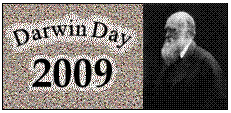Sunday Science Book Club, February 15 2009
Monkey Girl: Evolution, Education, Religion, and the Battle for America’s Soulby Edward Humes
HarperCollins, 2007

It is rare for the world to see born on one day two towering individuals whose imprint on history is strong enough to be noted around the world 200 years later. Abraham Lincoln successfully saw the United States through a near-fatal convulsion, whose early symptoms had been palliated but not cured at the nation’s founding; the after-effects have reached all around the world. Charles Darwin, more than anyone else in the 19th century, put biology on its modern scientific footing, and his ideas play a critical role in the genome sciences at the very forefront of 21st century biology.
We celebrate their achievements this week, but both Lincoln and Darwin have left legacies of divisiveness, and in fact these legacies intertwine. The contours of the rift that initiated the Civil War still shape American politics, from Nixon’s influential
Southern Strategy to the
Red State-Blue State divide in the 111th Congress. Evolution is a poster child for culture war. It may not be a top issue on the national political agenda, but it is a culture war conflict that penetrates just as deeply and personally than any other, as Edward Humes vividly describes in
Monkey Girl, the best book about the nation’s first court trial over Intelligent Design in public schools.
 Melville on Science vs. Creation Myth
Melville on Science vs. Creation Myth Non-coding DNA Function... Surprising?
Non-coding DNA Function... Surprising? Yep, This Should Get You Fired
Yep, This Should Get You Fired No, There Are No Alien Bar Codes In Our Genomes
No, There Are No Alien Bar Codes In Our Genomes









